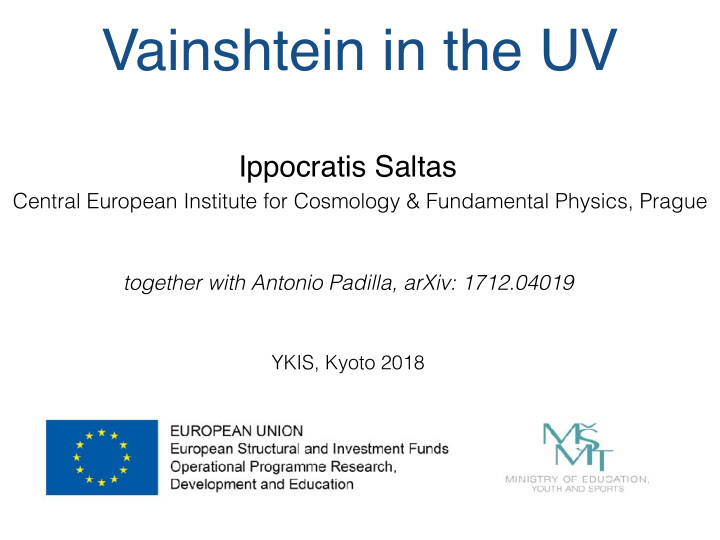



Vainshtein in the UV Ippocratis Saltas Central European Institute for Cosmology & Fundamental Physics, Prague together with Antonio Padilla, arXiv: 1712.04019 YKIS, Kyoto 2018
Motivation Theories for dark energy and inflation usually treated as effective theories tested against observations They often rely on dominance of non-linear derivative interactions Quantum features at strong coupling? UV initial conditions? UV completion? Aim: An understanding within a non-perturbative Wilsonian framework
Cosmology with derivative interactions P(X) theories, galileons, … strong coupling scale Vainshtein screening Implications of strongly-coupled configurations at the quantum level?* * Previous analysis on quantum stability: C. de Rham & R. H. Ribeiro (2014), arXiv: 1405.5213
The Wilsonian framework for QFTs UV completion? Effective theory at cut-off Fluctuations integrated out iteratively All fluctuations are integrated out
From UV to IR à la Wilson The tool: An Exact Renormalisation Group equation for the coarse-grained effective action* Wilsonian regulator RG flow of interaction couplings from UV to IR Critical points of the RG flow: UV completion? Asymptotic Safety? *C. Wetterich (1993), T. R. Morris (1994)
Asymptotic Safety Irrelevant coupling: Naive dimensional analysis: Asymptotic safety: In principle, of non-perturbative nature
Derivatively coupled scalars: UV completion? Can P(X) theories be UV completed through asymptotic safety ? Critical points equation: Non-linear, differential equation for P(X) and its derivatives w.r.t X P(X) theories: Their non-perturbative RG flow possesses no UV fixed point irrespective the form of P(X) Theory is trivial Can only be treated as EFT up to some UV cut—off
Derivatively coupled scalars: UV completion? But, what about higher-order derivative interactions? Results persist under higher-order corrections: No apparent UV completion beyond EFT Running couplings from the UV cut—off to IR (numerical)
So far, background configurations (gradients) were still assumed to be in the perturbative regime. What can we say about strongly-coupled configurations?
RG flow for strongly—coupled configurations Large derivative configuration: Dominant operator As 0 Absence of running: A (scale invariant) fixed point of the RG flow at strong coupling as Λ —> 0 A hint of classicalisation?* *G. Dvali et al. (2010)
Implications (Non-perturbative) UV completion: No UV completion — theory is trivial EFT approach the only path Should one worry about the absence of a UV completion? Lack of fundamental control upon UV initial conditions Still, all our realistic theories are EFTs ‘’Freeze’’ of the RG flow for large-derivative configurations: Strong sensitivity on the UV initial conditions A window to UV physics?
Summary Understanding the initial conditions and short-scale properties of dark energy theories is an important task No apparent Wilsonian UV completion for sufficiently general, derivatively coupled scalar fields beyond EFT Suppression of the RG flow for strongly coupled configurations: Theory is fixed to its classical, UV boundary Thank you!
Recommend
More recommend